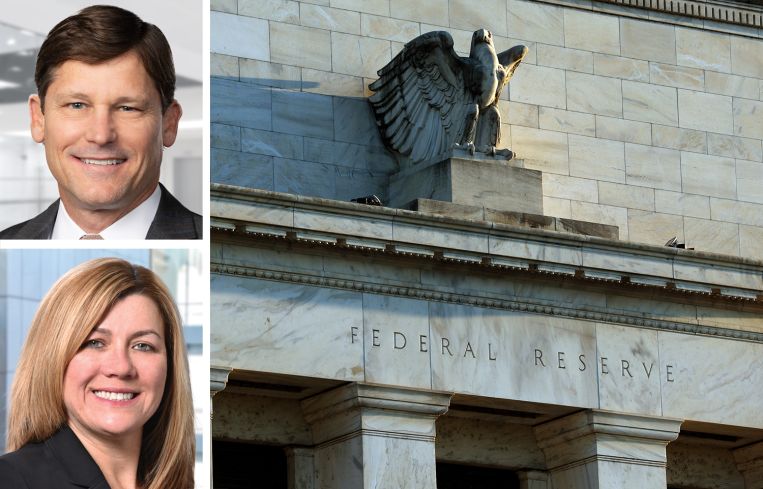MBA Expo 2025: Distress, Optimism, Interest Rates and Some Concern on Values
Hundreds of CRE’s top finance professionals gathered in San Diego to assess the economy and state of the lending marketplace
By Brian Pascus February 11, 2025 10:42 am
reprints
Amid swaying palm trees, a seaside breeze and flocks of white seagulls, the 2025 Mortgage Bankers Association Commercial/Multifamily Finance convention and expo opened in Downtown San Diego at the Manchester Grand Hyatt hotel. As tennis star Andre Agassi hobnobbed with brokers and lenders, the hot topics on everyone’s lips centered around the economy, interest rates, workouts and distress.
The conference began with Mike Fratantoni, chief economist and senior vice president of research at the Mortgage Bankers Association, holding a symposium on the state of the economy as we begin 2025.
Fratantoni cited a chart presented by Reggie Booker, associate vice president, which showed that $957 billion worth of commercial real estate loans will come due in 2025, or roughly 20 percent of the $4.8 trillion of outstanding CRE debt in the market. Taking into account an additional 15 percent of CRE loans due in 2026, 35 percent of all CRE maturities are due in the next two years, he said.
“There’s going to be a significant amount of distressed transactions in the industry this year — that’s a given,” said Fratantoni. “By the same token … that will be an opportunity for people, there will be a lot of business done this year, as those properties get repositioned and refinanced.”
Fratantoni was more pessimistic when it came to both the U.S. and global economies, which he called “a very complex macroeconomic environment,” with winds blowing in several directions based on intersecting trends that range from currency fluctuations, tariffs and employment levels to inflation readings, deficits, and interest rate fluctuations.
All told, despite the economic wild cards, Fratantoni said that by this time next year he doesn’t expect the long-term 10-Year Treasury, or the short-term Federal Funds Rate, to change from their current yields that each exceed 4 percent but are below 5 percent.
“Next year at this time, I’m not going to be surprised if the Fed Funds target rate is not very far from where we are today,” he said. “We’re at 4.5 percent for the 10-Year today, and our forecast is, again, on a quarterly average basis, over the next couple of years, 4.5 percent is about where we’ll be.”
However, federal spending by the Trump administration could change that calculation. The federal debt stands at $30 trillion, and an extension of the 2017 Tax Cuts and Jobs Act would add $5 trillion to the deficit over 10 years, noted Frantantoni.
“But if the bond market starts giving them the sharp elbow to the stomach, saying, ‘If you do certain things on the spending and tax side that really will begin to lead us to question the ability to service debt over the long term,’ then there will be a pushback on rates,” he said.
Fratantoni added that global economic weakness could also pull down the 10-Year Treasury yield to stay at 4 percent, as frantic capital will flock to the perceived safety of U.S. Treasurys. But if global investors care more about inflation and U.S. budget deficits and debt, “then we’ll be at 5 percent,” he said.
During a panel that focused on how to navigate CRE debt valuation, several speakers took aim at the chaos caused by the Fed’s aggressive interest rate regime since 2022, and how much the 500 basis points increase paralyzed CRE transactions and price discovery.
“If there’s anything certain about 2025, it’s the uncertainty that’s out there,” said Matthew Rocco, president of Colliers Mortgage. “Whether it’s in the transactions marketplace, which has been subdued, or the capital markets space, where there’s been a lot of disintermediation, there’s just a lot of unknowns.”
Beau Jones, executive managing director at Trimont, optimistically argued that we’ve “hit a ceiling” on interest rate hikes, and that the worst days of “extend and pretend” in 2024 are now behind us, paving the way for a more active 2025 on the deal front.
“We’ll see some true resolution because we have started to see transactional activity. You can actually have some comfort level of where values are,” said Jones. “Over the past year, everyone just didn’t know, and they weren’t willing to do trades because they didn’t want to get burned and look like an idiot.”
Brian Hanson, managing director of CWCapital Asset Management, said that even if there’s increased optimism among lenders, sponsors and investors to make deals, the lack of accurate appraisal in the market today stretches across asset classes, making things murky.
“Figuring out what these assets are worth is the holy grail,” he said. “Just trying to get our arms around value, which helps us determine the strategy to pursue, is very difficult — appraisals still seem to be lagging in the market. It’s a constant discussion.”
Marc McDevitt, director at Kroll Bond Rating Agency, said his firm has found that brokers’ opinion of value (BOVs) are a more conservative way to determine value, as the BOV carries the experience of brokers in specific markets compared to a traditional appraisal that uses data and metrics for a disparate group of outsiders. But, ultimately, both methods provide answers.
“The BOV is almost a substitute with the lower sales transaction data because you look at the price discovery,” he said. “But we’ve always had appraisals, looking through the data of 300-to-350 page reports, and kind of parsing that data, whereas BOV you might not get that context.”
The final panel of the day concerned how lenders can implement complex deal structures to resolve deals in a dynamic marketplace.
David A. Harrison, chief operating officer at PNC Real Estate, said there is an ongoing disconnect between the intuition used by borrowers and lenders of structured originations and the actual execution of it in the day-to-day business of servicing. Harrison used the example of a recent large CMBS conduit loan his team dealt with that had over 100 covenants attached to it.
“That’s just ridiculous. If there’s that much risk that has to be accounted for in the loan, then I think there’s a bigger issue at hand,” he said. “A lot of times things sound good on a white board, but in the servicing system, reality ends up being much different.”
But an increasing number of borrowers are using creative techniques to bridge the gap between themselves and their lenders. Melissa A. Farrell, managing director at PGIM Real Estate, said that interest rate buydowns — when a borrower pays more money to their lender upfront to secure a lower interest rate over the long term — have become “more and more prevalent,” especially on the agency front.
However, Farrell cautioned that this is a gamble, especially when there’s a risk of inflation and higher interest rates in the future.
“We’d all love to think rates are going down. That’s been the sentiment. But if they don’t, then you just upped your loan proceeds and managed to get your rate to a lower level,” she said. “But on the back end, you still have to get out of the loan. So for us [as lenders], it’s a bit of a harder story.”
Derek Vander Veen, senior vice president at Grandbridge Real Estate Capital, added that in previous years many clients were willing to write equity checks to rightsize underwater loans, but “that seems to be going away as of late,” and that his firm has gotten increasingly busy with extension tests that fail to meet debt yield hurdles, leaving sponsors desperate for rescue capital.
To this end, Vander Veen is bullish on floating-rate capital and debt funds to grow its equity footprint in 2025.
“I think we’ll see a good year in bridge space and floating rate capital space,” he said.
But Stefanie Stewart, senior vice president, Voya Investment Management, said she has found that many bridge loan investors have had enough of the distress machinations and are essentially saying, “Enough is enough,” creating new opportunities for capital stacks to secure fresh equity partners and maybe even transact into new ownership once the dust settles.
“On bridge loans that are coming due, and a lot came due 12 months ago, [our investors] got a very small paydown, a very small fee, we kicked the can,” she said. “The equity guys are saying ‘I’ve been in these deals for four or five years, I’ve made my money, I want out,’ so I hope that will drive investment sales and we’ll see it continue to tick up.”
Brian Pascus can be reached at bpascus@commercialobserver.com



